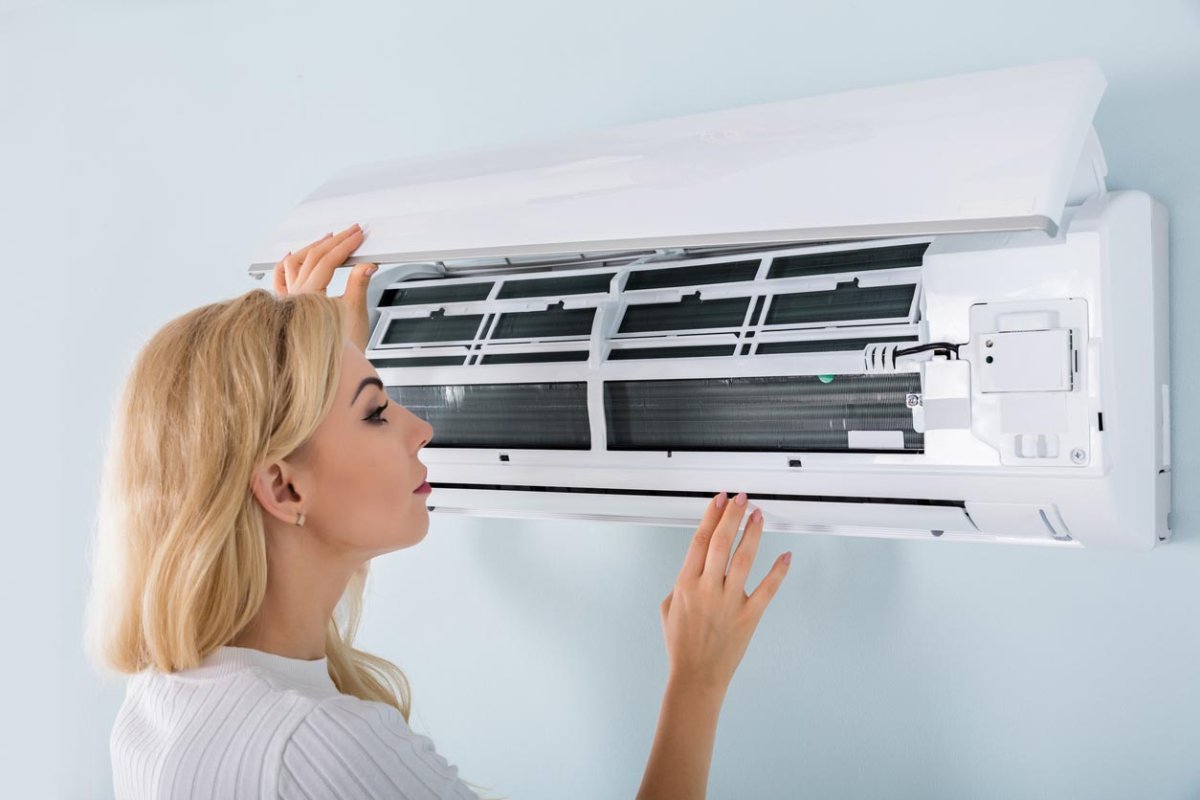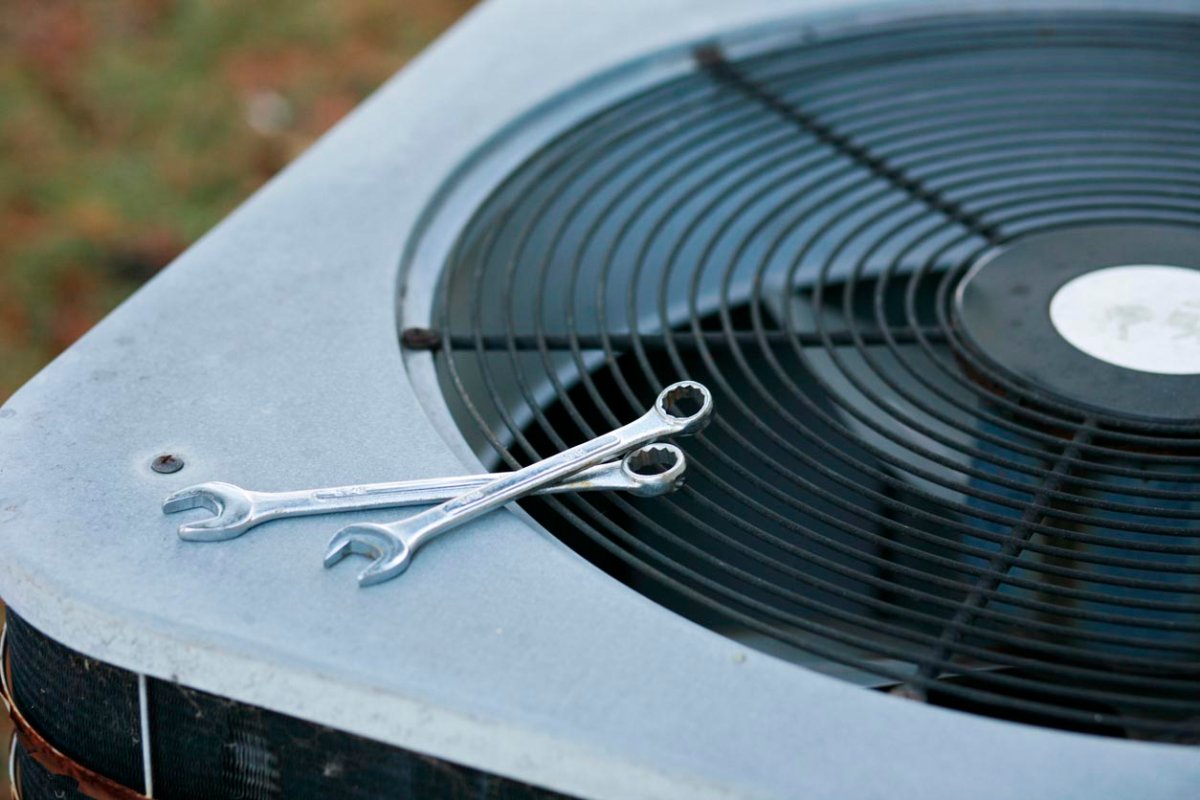

We may earn revenue from the products available on this page and participate in affiliate programs. Learn More ›
What You Need to Know
- Before contacting their homeowners insurance provider, policyholders will want to read their policy carefully to see what perils are covered.
- If the damage is covered, the policyholder will want to gather information such as the AC unit’s serial number and photos of the damage to submit when filing a claim.
- In some cases, the policy deductible may be higher than the AC repair cost, so homeowners will want to consider whether filing a claim is necessary.
- Upon filing a claim, homeowners will meet with an insurance adjuster, and if the claim is approved, they will receive payment to help repair or replace their air conditioner.
For many homeowners, a functioning air conditioner is a necessity when the weather gets hot. So when the AC unit fails, homeowners want to get it fixed or replaced as soon as possible. Repairing or replacing an AC unit can be expensive, so homeowners may wonder whether they can get the cost covered by their homeowners insurance policy. So, will home insurance cover AC unit repairs or replacement, and if so, how?
The answer depends on the cause of the damage. In some cases, the best homeowners insurance companies (like Allstate or Lemonade) might cover the cost of repairing or replacing a damaged AC unit, though homeowners will still be on the hook to pay their deductible. Homeowners can follow these eight steps to learn how to get home insurance to pay for air conditioner repairs if their unit qualifies.
STEP 1: Read your policy carefully to understand what is and isn’t covered when it comes to the home’s AC unit.

If an AC unit goes out, homeowners might ask, “Does homeowners insurance cover AC?” The answer depends on several factors, including why the air conditioner went out in the first place. Generally, homeowners insurance will cover air conditioner unit repair costs if the damage is caused by a covered peril. AC coverage typically applies when the damage is caused by storms, hail, wind, and fire. Theft and vandalism are also covered. Homeowners will want to carefully read their policies to understand what is and isn’t covered.
An AC unit can sustain damage for other reasons, too. The answer to “Is AC covered under home insurance?” can change depending on what caused the damage. For example, home insurance policies won’t pay for air conditioner repairs if damage is from:
- Regular wear and tear to the unit
- Lack of maintenance or neglect
- Flood damage, which is typically covered by a separate insurance policy
- Mechanical breakdowns
STEP 2: If the damage to the unit is covered, document the damage with photos or videos and get a copy of the police report (if applicable) to show your insurer.
The first step in filing a claim is for the policyholder to thoroughly document the damage. Photos and videos from multiple angles can help an insurance agent or adjuster better understand the extent of the damage. Homeowners may want to plan to capture visual records of all visible signs of damage, including broken components, water leakage, or obvious electrical issues. In addition to visual records, homeowners may want to create a detailed written record of the event. Written notes could include the date and time of the damage, as well as any other important information.
To file an insurance claim, most insurance companies require that a police report is filed. The owner can then get a copy of the police report to help support their claim to their insurance company.
STEP 3: Note the model and serial number of your AC unit.
Recording the model and serial number of the AC unit can help homeowners and their insurance companies better determine the cost of replacing the unit through AC insurance. To find their model and serial number, homeowners can look for the manufacturer’s label or nameplate. This information is often located on the indoor unit of an HVAC system, such as the evaporator coil, which is often found in a utility closet or basement of a home. Homeowners can generally find serial number information on a metal or sticker label on the side of the unit near the blower compartment or on the inside of the front panel. This may require homeowners to remove a panel or open a hatch to access.
Serial number and model information for the outdoor unit, or condenser, can typically be found on the back of the unit. There may be a metal casing or a label near the electrical connections of the unit. Some units may have a small hatch or panel that is removed with a screwdriver and has model information on the inside. Homeowners may also be able to find their model and serial number information if they still have access to an owner’s manual or installation documentation for their unit.
STEP 4: Determine whether filing a claim is worth it.
Even if a homeowners insurance policy can be used for covering AC claims, filling a claim isn’t always worth it for the homeowner. Homeowners may want to do a few light calculations to help figure out if it makes financial sense to file an insurance claim for their broken AC. If a homeowner’s insurance deductible (the portion of the claim that the policyholder is responsible for covering) is more than the repair or replacement cost of the AC unit, it probably isn’t worth filing a claim. However, it also may not make sense to file a claim if the repair costs are not significantly more than the deductible, as filing a claim could affect a homeowner’s future insurance rates. Homeowners will want to ask their insurance company or agent about how filing a claim might affect their rates.
For example, if a homeowner’s insurance deductible is $1,000 and their AC unit repair will cost $800, the homeowner’s deductible would be higher than the cost of the repair, and they wouldn’t receive a payout from their insurance company. Likewise, if the repair costs are $1,200 but filing a claim would increase premiums by $200 per year, it probably doesn’t make sense for the homeowner to file a claim.

STEP 5: If you decide to move ahead, contact your insurer to start the claims process.
After assessing whether it’s worth it to file a claim, the homeowner can get in touch with their insurance company to start the claims process. Most insurance companies have 24/7 claims hotlines or online claims portals to make it easy for customers to file claims of any kind, including air conditioner insurance claims. Some homeowners insurance companies may even have a mobile app that policyholders can use to file a claim and upload important claim documents, such as photos of damage or serial number information, directly from their mobile device.
It’s a good idea for homeowners to keep a record of any interaction they have with their insurance company or any details they provide through a website or mobile app. If a homeowner speaks with a representative on the phone, for example, they may want to write down the date and time of the call, who they talked to, and any specific information relayed on the call. Detailing their communications during the claims process can help a homeowner stay organized and keep their insurance claim on track.
STEP 6: Meet with the insurance adjuster to assess the damage.
Homeowners insurance companies often require an insurance adjuster to visit a home and assess damage to an AC unit after a claim is filed. The homeowner can typically schedule an appointment with the adjuster for a time that works for their schedule, though the insurance company may have a required timeline for assessing damages. Before the adjuster comes, the homeowner may want to gather their documentation regarding the damage to the unit, such as photos of damage or police reports. Having documentation handy can make it easier for the adjuster to locate and accurately assess the air conditioner’s damage.
During the appointment, the insurance adjuster will work with the homeowner to pinpoint specific issues or damage to the AC unit. They will also try to accurately answer any questions the homeowner may have about the extent of the damage. The homeowner will also need to answer any questions from the adjuster to get the most accurate insurance payout for their claim.

STEP 7: Wait for approval and receive payment for the repair or replacement.
Once an insurance company approves a homeowners insurance claim, it provides payment to help repair or replace the air conditioner. Some insurance companies provide half of the funds for the claim when the work starts and the remainder of the payout once the repair or replacement is complete. Homeowners will want to ask their insurance company how the claims payout process works so they aren’t caught off guard.
Additionally, homeowners may want to know what type of repair or replacement coverage they have on their air conditioner. Typically, home insurance offers two types of coverage: replacement cost and actual cash value coverage. Replacement cost coverage pays for the cost of replacing the home’s AC unit with a comparable new model at today’s prices. Actual cash value coverage, however, only pays for the depreciated value of the unit, which could leave the policyholder paying more out of pocket for a comparable AC unit.
STEP 8: If the repair or replacement isn’t covered by insurance, check your home warranty policy, if applicable.
Traditional homeowners insurance isn’t the only way homeowners can protect their investments. Many homeowners have additional home repair coverage through a home warranty coverage contract. A home warranty is a service contract between the homeowner and the warranty company. The homeowner pays a premium for coverage in addition to a service fee when the coverage is used, and the warranty company agrees to pay for repairs or replacement if conditions are met. Unlike homeowners insurance, home warranties are designed to protect homeowners from paying for damage due to age and normal wear and tear of the home’s appliances and systems. In some cases, a home warranty can be worth it to reduce the cost of regular repairs to older appliances or other home systems.
Some homeowners may wonder “Does a home warranty cover AC?” Many home warranty companies offer coverage for whole-home systems, including home warranty AC unit coverage. Homeowners with one of the best home warranties for HVAC (such as coverage through American Home Shield or Liberty Home Guard) can check with their provider to determine if their air conditioner is covered by their contract.
